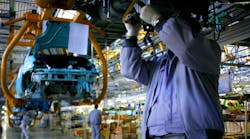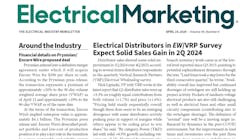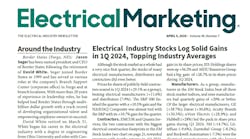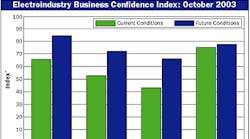October’s results mark the third consecutive month in which the current conditions index remained above 50, which is the threshold indicating conditions are favorable for growth, in all regions except Europe, according to the National Electrical Manufacturers Association (NEMA) Electroindustry Business Confidence Index.
Based on the results of a monthly survey of senior managers at member companies of NEMA, Washington, D.C., confidence in business conditions for three of the four regions was slightly more widespread than in September. Latin America was the only region to see a decline in the current conditions index.
Latin America bucked the trend again, this time regarding future conditions. Although all four regional indexes remained above 50, the values for North America, Europe, and Asia/Pacific declined from their September levels. However, the future conditions index in Latin America demonstrated increased breadth of confidence as it moved up nearly 10 points from its September value to reach 72 points this month.
Current Conditions. Perhaps it should be called “soft” confidence. Several comments by the EBCI panel members alluded to improved business conditions, but most of the positive remarks were tempered by mild caveats. Some respondents described the improvement in current conditions as slow, but indicated that, even though not necessarily robust, the trend is positive nevertheless. One respondent cautioned that recent improvements might be reflecting a return to normal seasonal patterns. And while some respondents characterized conditions as being improved, they also pointed out continuing weakness in key markets such as utilities and commercial, retail, and retro-fit construction.
Another theme may be found in the comments that were less positive. Panelists with less sanguine views of business conditions are largely concerned about pressure on profit margins. Those respondents are experiencing margins that are being squeezed from both sides. Businesses are being faced with ever increasing costs, especially for energy and health care benefits, but because of the weak pricing environment those increased costs cannot be fully recuperated by manufacturers.
Future Conditions. The uniformly positive index numbers for future conditions seem to be largely based on a sense of improvement relative to the bottom of the trough. The economic stimulus provided by U.S. monetary and tax policy received some plaudits from the panel, along with the hope that its effects will translate into growth in the rest of the world and concern that the economy, generally, and manufacturing, in particular, will continue to reap the benefits of those policies once the initial jolt has faded.
One respondent expected the Federal Reserve Board’s loose money policy to continue throughout the election year. Another respondent is actively expecting greater activity in the commercial and industrial markets. Finally, the status of the energy bill remains a concern of the electrical industry, especially for those companies that supply the utility sector.









